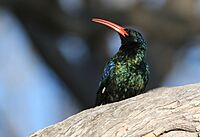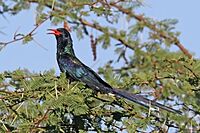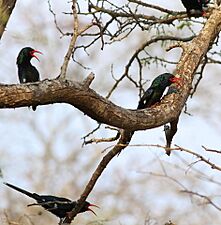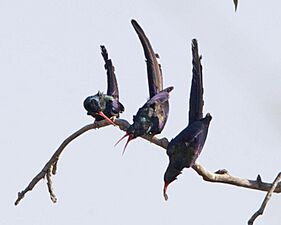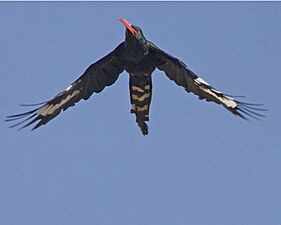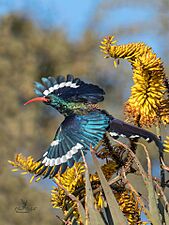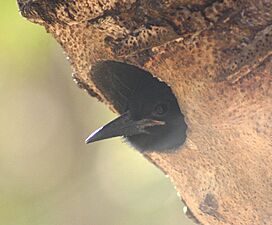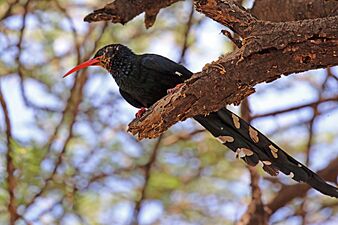Green wood hoopoe facts for kids
Quick facts for kids Green wood-hoopoe |
|
|---|---|
|
P. p. angolensis in Zimbabwe
|
|
| Conservation status | |
| Scientific classification | |
| Genus: |
Phoeniculus
|
| Species: |
purpureus
|
The green wood-hoopoe (Phoeniculus purpureus) is a large, colorful bird found in Africa. It can grow up to 44 cm (about 17 inches) long. This bird is part of the wood hoopoe family, called Phoeniculidae. It used to be known as the red-billed wood-hoopoe.
Contents
About the Green Wood-Hoopoe
The green wood-hoopoe is a very common bird in many parts of Africa. It lives in forests, woodlands, and even in gardens in towns. These birds often live in groups, which helps them survive and raise their young.
What Does It Look Like?
This bird has a shiny, metallic dark green body. Its back and very long, diamond-shaped tail are purple. You can easily spot it because of the white marks on its wings and white V-shapes on the edges of its tail. It also has a long, thin, curved red beak.
Male and female green wood-hoopoes look very similar. However, young birds have a black beak instead of a red one.
What Does It Sound Like?
You can often hear the green wood-hoopoe before you see it! It makes a loud call that sounds like kuk-uk-uk-uk-uk. They also make other noises to talk to each other.
Behavior and Life
How Do They Find Food?
Green wood-hoopoes love to eat insects. They usually look for food on the ground, near termite mounds, or on tree trunks. They have special claws that help them hold onto the underside of branches. This way, they can carefully check the bark for hidden insects. Outside of the breeding season, they often form groups to search for food together.
Reproduction and Family Life
Green wood-hoopoes are special because they are cooperative breeders. This means that more than just the parents help raise the young. A group can have up to a dozen birds, but usually only one pair will breed.
The female bird lays two to four blue eggs in a natural hole in a tree or in an old nest made by another bird called a barbet. She sits on the eggs for about 18 days until they hatch. Once the chicks are born, the whole group helps feed the mother and the baby birds. They continue to feed the young even after they leave the nest. The group is very brave and will protect the nestlings from anything that tries to bother them.
Sometimes, other birds called greater and lesser honeyguides lay their eggs in the green wood-hoopoe's nest. This is called brood parasitism.
Where Do They Live?
The green wood-hoopoe is found all over sub-Saharan Africa, which is the part of Africa south of the Sahara Desert. Because it is so common and found in many places, experts say it is a species of Least Concern. This means it is not currently in danger of disappearing.
Gallery
-
P. p. niloticus at Lake Baringo, Kenya


